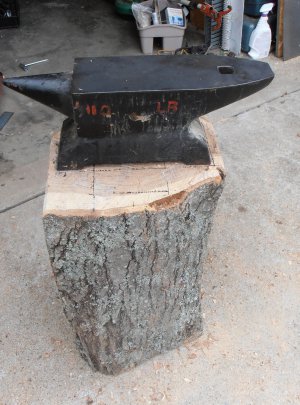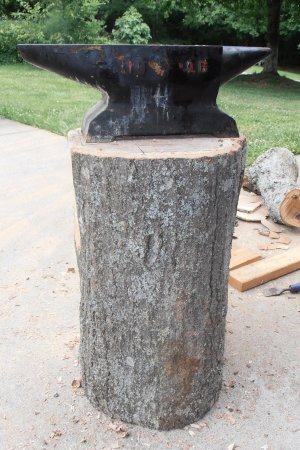- Joined
- Oct 6, 2010
- Messages
- 699
I put this question here after looking for a better place to file it. Hope it is close enough to Hobby Machining to fit okay.
I adopted an anvil off Craigslist some time ago and it has been setting in the shop floor wanting for a real resting place. It is fairly large with a 6 inch by 13 inch mounting base. I had thought of building a metal stand on wheels for it but really like the idea of an old wooden "stump" that would help keep it quite. This week I finally got a large enough piece from an oak tree when a storm dropped it across a neighbor's drive gate.
Today I trimmed the oak log with the chain saw so that the top is fairly parallel with the bottom and used a wood chisel to level the top surface so the anvil does not rock. I still need to make some means to hold it in place like metal straps, chain or something. The overall height is a little short of what is recommended. I still like the idea of it setting on wheels so it can be moved around easily so that project may be down the road.
I had another piece of wood given to me that was a little too small and it was setting outside in fount of the barn. We have had a lot of rain this year and little mushroom like thingies are growing from it. I mention this because the anvil is likely to be left outside once in a while and get wet. I don't want things growing on this nice piece of wood.
The question is.................what is the best method to treat the wood so that it does not dry too fast, can deal with getting wet, and will look nice?
I have attached a couple of photos below showing the project at the end of the day.


Benny
The Orphanage Never Closes


I adopted an anvil off Craigslist some time ago and it has been setting in the shop floor wanting for a real resting place. It is fairly large with a 6 inch by 13 inch mounting base. I had thought of building a metal stand on wheels for it but really like the idea of an old wooden "stump" that would help keep it quite. This week I finally got a large enough piece from an oak tree when a storm dropped it across a neighbor's drive gate.
Today I trimmed the oak log with the chain saw so that the top is fairly parallel with the bottom and used a wood chisel to level the top surface so the anvil does not rock. I still need to make some means to hold it in place like metal straps, chain or something. The overall height is a little short of what is recommended. I still like the idea of it setting on wheels so it can be moved around easily so that project may be down the road.
I had another piece of wood given to me that was a little too small and it was setting outside in fount of the barn. We have had a lot of rain this year and little mushroom like thingies are growing from it. I mention this because the anvil is likely to be left outside once in a while and get wet. I don't want things growing on this nice piece of wood.
The question is.................what is the best method to treat the wood so that it does not dry too fast, can deal with getting wet, and will look nice?
I have attached a couple of photos below showing the project at the end of the day.


Benny
The Orphanage Never Closes



